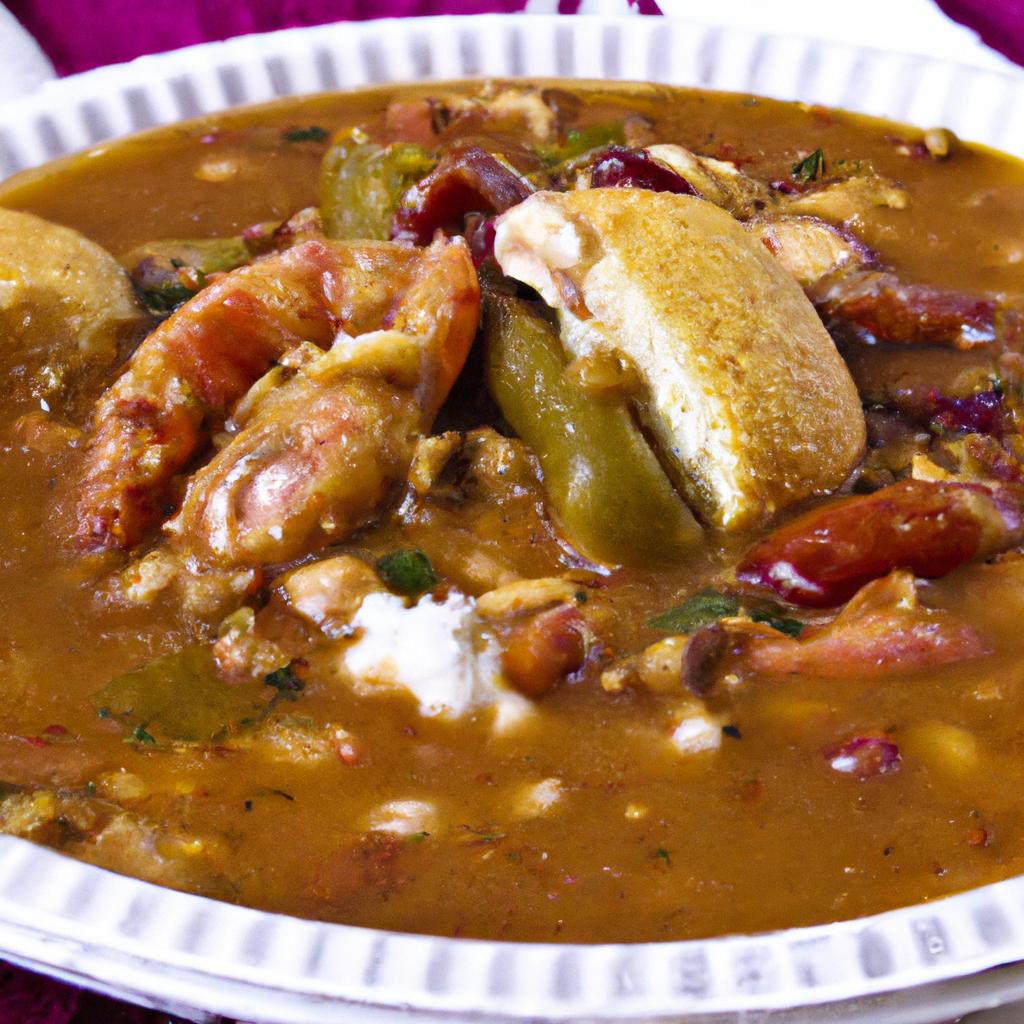Gumbo

For many, Southern gumbo is more than just a hot and spicy stew. It’s a reflection of their cultural and culinary heritage, a dish steeped in both history and tradition.
Gumbo’s inception can be traced back to the early 1700s when French colonists settled in Louisiana and brought with them their love of cooking. The dish itself is a melange of African, Native American, and European flavors, boasting a complex blend of spices and ingredients that can vary depending on the region and season.
Traditionally, gumbo is made with a roux, a mixture of flour and fat, which is cooked slowly to a deep, rich, caramelized color. The roux serves as the base for the dish, providing not only flavor but also thickening the stew to give it its signature texture.
One of the unique features of gumbo is the “holy trinity” of vegetables: onion, celery, and bell pepper. These three ingredients are sauteed in the roux until softened and fragrant, adding depth and complexity to the gumbo.
The protein used in gumbo can vary, from smoked sausage to seafood, chicken, or even alligator, which is characteristic of Cajun cuisine. The addition of seafood is common in coastal areas, while other versions rely heavily on andouille sausage, which is heavily spiced and packs a flavor punch.
One ingredient commonly found in gumbo is okra, an edible flowering plant that originated in West Africa. Okra serves two purposes in gumbo: it helps thicken the stew and adds flavor. Another ingredient often used to thicken gumbo is filé powder, made from dried and ground sassafras leaves.
Seasoning plays an essential role in gumbo, with a mix of herbs and spices such as thyme, bay leaves, cayenne, garlic powder, and smoked paprika. The heat level in gumbo can also be adjusted based on personal preference, with some opting for a mild broth while others crank up the heat to leave a fiery finish.
Gumbo is often served over rice, providing a perfect complement to the spicy and flavorful stew. It’s not uncommon to find gumbo served with a side of cornbread, which pairs perfectly with the stew.
While gumbo may seem daunting to some, it’s a dish that can be customized to fit any kitchen and any palate. The recipe can be adapted by swapping out proteins or adjusting the spice levels, making it a versatile and accessible dish.
In the end, Southern gumbo isn’t just a dish; it represents a cultural and culinary landmark, embodying centuries of tradition, flavor, and community. It’s a dish that brings people together, sharing in the richness of its history and complexity one spoonful at a time.
Here is a recipe for Southern Gumbo:
Ingredients:
- 1 cup vegetable oil
- 1 cup all-purpose flour
- 1 onion, chopped
- 1 green bell pepper, chopped
- 3 celery stalks, chopped
- 4 cloves garlic, minced
- 1 lb. andouille sausage, sliced
- 1 lb. chicken breast, chopped
- 6 cups chicken broth
- 1 can diced tomatoes (14 oz.)
- 1 tbsp. Worcestershire sauce
- 2 bay leaves
- 1 tsp. thyme
- 1 tsp. paprika
- 1 tsp. cayenne pepper
- Salt and pepper
- 1 lb. shrimp, peeled and deveined
- 2 cups okra, sliced
- 3 cups cooked rice
- Chopped fresh parsley, for garnish
Directions:
- In a large pot or Dutch oven, heat the vegetable oil over medium-high heat. Whisk in the flour to make a roux, stirring constantly for 10-15 minutes until it turns light brown.
- Add the onion, bell pepper, celery, and garlic to the pot, and stir until the vegetables are coated in roux. Cook for 5-7 minutes until they start to soften.
- Add the sliced andouille sausage to the pot, and cook for 5-7 minutes until browned. Add the chopped chicken to the pot, and cook for another 5-7 minutes until browned.
- Pour in the chicken broth, diced tomatoes, Worcestershire sauce, and spices (bay leaves, thyme, paprika, cayenne pepper, salt, and pepper). Bring the mixture to a boil, then reduce the heat and let it simmer for 20-30 minutes until the flavors are blended.
- Add the peeled and deveined shrimp and sliced okra to the pot, and let them cook for 5-10 minutes until the shrimp are pink and cooked through, and the okra is tender.
- Remove the bay leaves from the pot, and serve the gumbo over cooked rice. Garnish with chopped fresh parsley. Enjoy!